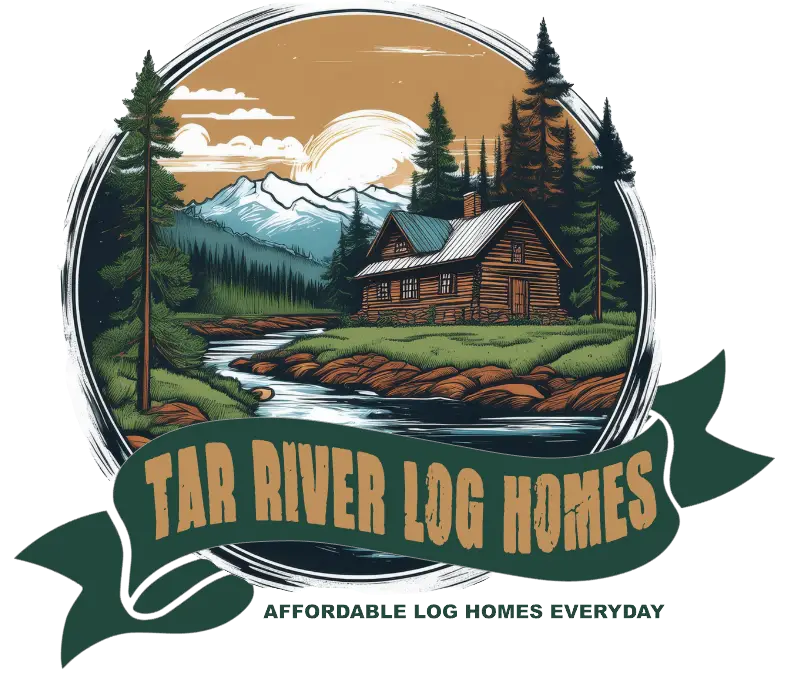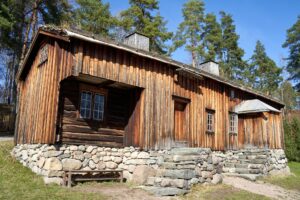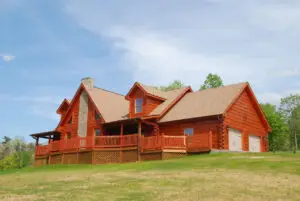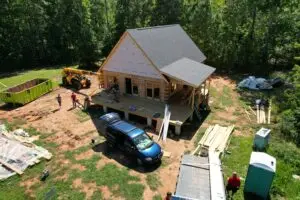Building a log home is a rewarding experience, but many families worry about the costs involved. Wondering how to save on log homes without losing quality or style? The key is making smart choices at the very beginning of the process.
Tar River Log Homes is dedicated to helping families balance cost with comfort. By choosing the right materials, sourcing logs wisely, and considering efficient designs, you reduce expenses without compromising.
Smart savings don’t mean cutting corners. Many homeowners save through prefabricated kits, locally sourced logs, and practical floor plans that eliminate wasted space. Energy-efficient windows, insulation, and sealing also help keep bills down long term.
In this guide, we’ll explore ways to reduce upfront costs, make smarter decisions, and enjoy lasting value from your log home.
Understanding Log Home Construction
Building a log home means making choices about design, materials, and efficiency that directly affect your costs and comfort. Knowing the types of log homes and the main cost drivers can help you plan better.
Understanding how energy efficiency works in these homes can save you money long term.
Types of Log Homes
You can choose from several log home styles, each with different construction methods and price points.
- Handcrafted or Custom Log Homes: Built with whole logs, crafted and shaped manually. These tend to be more expensive due to labor and material quality.
- Scribed Log Homes: The logs are fitted tightly with scribing tools to create a snug fit, which takes time but improves insulation.
- Prefab or Kit Homes: These come pre-cut and pre-drilled for easier assembly. They usually cost less and speed up construction.
Your choice affects material costs, labor, and project length. Prefab kits often save money but offer less customization compared to handcrafted types.
Common Cost Factors
Several factors determine how much your log home will cost, some of which you can control.
- Log Type and Quality: Pine logs may cost less than cedar or spruce, but have different durability and maintenance needs.
- Home Size and Design: Larger homes or complex shapes increase material and labor costs. Oversized rooms or unusual layouts add expenses.
- Foundation and Site Prep: The cost of leveling land, foundation types, and access to utilities impacts the budget.
- Labor and Builder Experience: Skilled log home builders might charge more upfront, but can reduce costly mistakes.
- Permits and Location: Local building codes and land prices vary widely. Some areas require expensive permits or have higher construction costs.
Planning your home’s size, layout, and choosing materials carefully helps control your expenses.
Energy Efficiency Basics
Energy efficiency in log homes can cut utility bills and improve comfort, but it depends on the build quality.
- Proper Sealing: The use of quality gaskets where logs join prevents drafts and heat loss.
- Log Profile: Some log styles include features like drip edges to direct water and reduce wood damage.
- Insulation: Although logs have natural insulating properties, adding insulation in the roof, floors, or basements is important.
- Windows and Doors: Energy-efficient units reduce heat transfer and improve overall home performance.
Focusing on these details during construction helps you build an energy-saving home that costs less to heat and cool.
Heating and Cooling Costs for Log Homes
Energy bills are a major ongoing expense, and log homes perform differently from conventional houses. The U.S. Department of Energy notes that proper insulation and air sealing can cut heating and cooling costs by up to 20%.
In log homes, this means paying special attention to roof insulation, tight log joinery, and efficient windows. By prioritizing these areas, you’ll see lower energy bills year after year.
Smart Design Choices to Reduce Costs
Your design decisions directly impact both construction expenses and long-term maintenance. By focusing on your home’s size, layout, and materials, you can set a strong foundation for savings.
Thoughtful planning helps you balance comfort with affordability without compromising the quality of your log home.
Optimizing Floor Plans
Start by keeping your floor plan simple and efficient. Smaller footprints reduce foundation costs and limit the amount of materials needed. Consider a two-story design instead of a sprawling ranch-style layout. Going vertical saves money on roofing and foundation work.
Only include rooms and features you truly need. Scaling back on room size or eliminating seldom-used spaces trims expenses.
Open floor plans can help you achieve a more spacious feel without adding square footage. Limiting complex corners and angles reduces labor time and waste.
Choosing Log Sizes and Species
The size and type of logs you select affect both your budget and your home’s durability. Larger logs can be more costly but may reduce labor because fewer pieces are needed.
Smaller logs might be cheaper upfront, but could increase construction time. Choosing a readily available local wood species usually saves money on transport and sourcing.
Pine and spruce are common, cost-effective options. Exotic or less common woods typically raise costs due to scarcity. Logs with fewer knots and imperfections reduce finishing work over time.
Prefabricated vs. Custom Designs
Prefabricated log home kits often cost less than fully custom builds. Kits come with pre-cut logs and ready-made components, cutting labor hours on-site.
This approach speeds up construction and lowers mistakes. If you want a custom design, expect higher costs for architectural work and specialized craftsmanship.
Custom designs give you flexibility but require careful budgeting. Modifying a stock plan to fit your needs can save design fees while still giving some personalization.
Selecting the Right Materials for Savings
Choosing the right materials impacts both your budget and the long-term durability of your log home. Your decisions on wood sourcing, sustainable options, and alternative components can reduce costs without compromising quality.
Local vs. Imported Logs
Using locally sourced logs often saves money on transportation and handling fees. Local wood also tends to be better suited to your climate, improving your home’s durability.
Imported logs may offer unique aesthetics or wood types, but usually come with higher costs. Consider the balance between style preferences and budget constraints before choosing imported timber.
Kiln-dried logs outperform green wood in durability and energy efficiency. Investing in kiln-dried local wood can reduce future maintenance and heating costs.
Sustainable Material Options
Opting for eco-friendly materials can lower operational costs over time. For example, using energy-efficient insulation and renewable power sources like solar panels can cut utility bills.
Sustainable wood options, such as certified responsibly harvested timber, help ensure your home is built with environmental care. This choice may also improve your home’s resale value.
Materials like half-log siding allow you to keep the log home look inside without the extra cost of full logs, saving on both materials and labor.
Alternative Building Components
You can save by combining full logs on exterior walls with conventional framing inside. This method reduces expensive log quantities while maintaining a log aesthetic.
Using half-log siding for interior walls can mimic the log home feel without the cost of solid logs. It also simplifies installation and reduces labor expenses.
Reclaimed materials or items from resale stores may provide quality components at a fraction of new material costs. Always check for structural integrity before use.
Budget-Friendly Log Home Construction Strategies
Saving on a log home involves smart planning, deciding where you can invest your effort, and having clear conversations about costs. You’ll want to manage the build in stages, choose between doing certain tasks yourself or hiring experts, and negotiate effectively with your builder.
Phased Construction Approach
Building your log home in phases helps spread out costs and timing. Start with the essential parts, like the foundation and main structure, then add finishes or extras later. This way, you can prioritize the budget for critical areas first.
Phasing also allows you to use savings or income from other sources as construction progresses. It can reduce stress on your finances and still get your home built without rushing or overspending. Plan each phase carefully to avoid rework.
Map out what must be done in each stage and what can wait. Discuss this plan upfront with your builder, so they align their work and invoicing accordingly.
DIY vs. Hiring Professionals
Taking on some tasks yourself can cut costs, but it’s important to know your limits. Simple jobs like painting, staining logs, or landscaping are great DIY options.
These tasks save money and add personal touches. However, complex work like electrical systems, plumbing, or structural assembly should usually be left to professionals.
Mistakes here can be costly and unsafe. Hiring skilled tradespeople ensures quality and compliance with building codes.
Use a list like this to decide:
- DIY Tasks: Painting, staining, landscaping, interior finishing
- Hire Pros: Electrical, plumbing, roofing, log assembly
Balancing what you do yourself with skilled labor maximizes savings without sacrificing safety or quality.
Negotiating With Builders
Clear communication is key when negotiating with builders. Start by showing your budget openly and asking where they can help reduce costs. Builders often have cost-cutting suggestions or access to better pricing on materials.
Ask for detailed quotes and compare them carefully. Don’t hesitate to request adjustments to design features, materials, or timelines to fit your budget better. You can also negotiate payment schedules.
For example, tying some payments to completed milestones can help manage cash flow. Respectful negotiation can lead to a win-win situation where your builder stays motivated and your budget stays on track.
Reducing Long-Term Log Home Expenses
Saving money on your log home goes beyond the initial build. Focusing on ways to lower heating and cooling costs, minimize upkeep, and avoid common structural problems will help you spend less over time.
Efficient Insulation Methods
Proper insulation is key to reducing your energy bills. For log homes, using high-quality chinking and caulking seals gaps between logs, which prevents drafts and heat loss.
You can also add foam board insulation to interior walls without compromising your home’s rustic look. Consider double-glazed windows to keep heat inside during winter and out during summer.
These energy-efficient windows can cut heating and cooling expenses noticeably. Installing airtight doors and weather stripping around frames will further reduce wasted energy.
By tackling insulation thoughtfully during construction or upgrades, you’ll keep your home comfortable year-round while lowering electricity and fuel costs.
Low-Maintenance Finishes
Choosing the right finishes can lessen the time and money you spend on upkeep. Use exterior stains or sealants designed for log homes to protect wood from weather damage.
These finishes should be UV-resistant and water-repellent to extend their lifespan. Opt for durable materials like metal or composite roofing that require less frequent replacement compared to traditional wood shingles.
Inside, select hardwood flooring or treated wood that resists scratches and moisture. By investing in finishes that last, you avoid costly repairs and repeated maintenance, keeping your log home looking great with less effort.
Preventing Moisture and Pest Issues
Moisture and pests are major concerns that drive up maintenance costs. To protect your home, keep gutters clean and well-maintained to channel water away from the foundation.
Ensure proper grading around your home so water doesn’t pool near logs. Use natural pest-resistant wood species or treat logs during construction to deter insects like termites.
Regularly inspect your home for signs of damage or infestation and address problems quickly before they worsen. By proactively managing moisture and pests, you’ll protect your investment and reduce expensive repairs over the years.
Financing and Incentives for Log Homes
You can lower your expenses by choosing the right financing methods and taking advantage of available incentives. Understanding loan options and knowing where to look for government support can make building your log home more affordable.
Exploring Loan Options
Financing a log home can be a bit different from traditional homes due to their unique construction. You’ll likely encounter construction loans, which release funds in phases as the build progresses.
These loans often convert to permanent mortgages after completion. Some lenders specialize in log homes and offer tailored products that accommodate custom features and timber materials.
Look for loans with competitive interest rates and flexible terms to avoid extra costs over time. Be prepared for the appraisal process; unique designs may require additional documentation or comparable sales data.
This helps lenders accurately assess the home’s value and your loan eligibility.
Government Grants and Tax Credits
Certain federal, state, or local programs offer financial incentives that can help reduce costs when building your log home. These include energy efficiency tax credits if your home uses renewable or sustainable materials and systems.
You may also find grants aimed at rural housing or eco-friendly construction, which apply to some log home projects. Check eligibility requirements carefully to see if your build qualifies.
To maximize these benefits, gather documentation like energy reports or certifications for sustainable materials. These will be necessary when applying for grants or claiming tax credits on your taxes.
Sourcing and Purchasing Quality Logs at Lower Prices
Finding the right logs without overspending involves knowing where to look and how to buy smartly. By focusing on quantity and choosing trustworthy sources, you can secure durable, quality timber for your log home while keeping costs down.
Tar River Log Homes is committed to helping regular families achieve their dream of owning a log home by offering the best materials at the lowest price, every time.
We provide only the best products for your log home, ensuring you get transparency, value, and support throughout your building journey.
Buying in Bulk
Buying logs in larger quantities usually gets you a better price per piece. Sellers often offer discounts for bulk purchases because it reduces their handling and shipping costs.
If you plan a sizeable project, consider ordering all your logs at once. Check if you can negotiate pricing based on volume or if the supplier offers bundled deals, such as kiln-dried and air-dried logs together.
Large orders can also lower your per-log transport cost. Make sure you store your logs properly after purchase to preserve quality. Buying too many logs without proper storage could lead to wood degradation, which wastes your investment.
Finding Reliable Suppliers
Look for suppliers with a solid reputation and transparent pricing. Local sawmills often provide fresh, quality logs and let you inspect the wood before buying.
This hands-on approach helps you avoid logs with defects. Wholesale log distributors can offer competitive prices because they buy directly from mills or logging operations.
Check reviews, ask for references, or visit the supplier’s yard if possible. You can also explore getting logs from land clearing services or local tree services, which might offer logs at lower prices. Just be sure to confirm the wood species and condition before committing.
Tips for Saving on Your Log Home
| Tip | Why It Helps |
| Choose efficient materials | Lowers heating and cooling costs |
| DIY selectively | Saves on labor but avoids critical jobs |
| Plan ahead | Minimizes costly changes during build |
| Use builder expertise | Access insider cost-saving tricks |
Careful planning and smart material choices help keep your log home project affordable. Tar River Log Homes is committed to making high-quality log homes accessible to regular families.
Building Smart, Saving More
Saving money on a log home comes down to thoughtful choices at every stage of the project. By balancing design, materials, and efficiency, you can create a space that feels timeless while staying within budget. The right planning prevents overspending and keeps your build on track.
Tar River Log Homes provides affordable, high-quality materials that make building a log home possible without compromise. With the right guidance and resources, your dream of a comfortable and stylish home can be achieved on a budget.
Remember, small decisions like choosing local logs, planning a simpler floor plan, or investing in energy-saving upgrades can make a lasting difference. Start planning today and take confident steps toward building the log home you’ve always envisioned.
Ready to begin your journey? Explore cost-saving options and learn how to build a log home that fits your budget and lifestyle.
Frequently Asked Questions
Saving money on your log home involves careful planning around materials, design, and energy use. Understanding insulation, roofing options, and seasonal heating can help control ongoing costs. Insurance costs also vary compared to traditional homes and depend on several factors.
What are cost-saving measures when building a log home?
You can save by selecting simpler designs without elaborate features like cathedral ceilings or exposed beams. Choosing locally sourced logs reduces transportation expenses. Managing your permits and selecting experienced builders familiar with log homes also helps keep costs down.
How can I improve the energy efficiency of my log cabin?
Sealing gaps and cracks in the logs prevents air leaks. Installing energy-efficient windows and doors reduces heat loss. Adding weatherstripping and using high-quality exterior stains can improve your cabin’s overall thermal performance.
What are the best insulation practices for log homes?
Use spray foam or rigid foam insulation in the roof and floors. Adding insulation around window and door frames reduces drafts. Properly insulating your log home’s roof and foundation is essential to maintain consistent indoor temperatures.
Can installing a cool roof reduce energy costs in log homes?
Yes. Cool roofs reflect more sunlight and absorb less heat, which lowers cooling expenses during warmer months. If your log home is in a hot climate, a cool roof can be a practical investment to reduce energy usage.
What is the average cost of insurance for a log home compared to traditional homes?
Log home insurance often costs slightly more due to materials and unique risks like increased fire concerns. Your location, construction quality, and safety features will influence the exact price. Shopping around for specialized log home insurance providers can help you find better rates.
Our team is here to answer your questions and guide you toward building the log home you’ve always wanted.
What factors influence the heating costs of a log home in winter seasons?
Insulation quality and window efficiency are key factors that impact heating expenses. The size of your home also plays a significant role in overall costs. Using energy-efficient heating systems helps manage winter heating bills.
Maintaining proper log care to avoid drafts is important for keeping warmth inside. The local climate can greatly influence how much you spend on heating. Our goal is to help families make informed choices about log home efficiency so they can enjoy comfort and save money long term.




